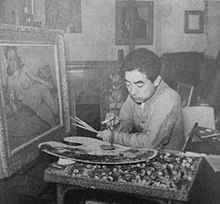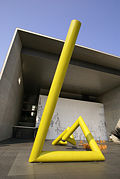Inokuma Gen'ichirō
Inokuma Gen'ichirō ( Japanese 猪熊弦一郎 ; born 14 December 1902 in Takayama in Kagawa Prefecture ; d. 17th May 1993 ) was a Japanese painter of yoga direction in the Showa period .
life and work
Inokuma Gen'ichirō graduated from Marugame Middle School in 1921 and then went to Tokyo to study Western-style painting - Yōga - at a private art school, Hongō Yōga kenkyūjo ( 本 郷 洋 画 研究所 ). The following year he continued his education under Fujishima Takeji . In 1926 his picture “Portrait of a Woman” ( 婦人 図 Fujin-zu ) was accepted at the 6th Teiten exhibition. In the same year his health was bad, so he left school.
In 1929 Inokuma received an award at the 16th Kōfū-kai exhibition and also at the 10th Teiten exhibition his picture "Seated Representation" ( 座像 Zazō ) was praised. He also attracted attention at the 14th Teiten exhibition in 1933 with “Studio” ( 画室 Gashitsu ).
In 1935 he organized the "Second Branch Association" ( 第二部 会 , Dai-ni bukai) together with some opponents of the Shin- Bunter exhibition. He left it the following year, when members also exhibited at the Shin-Bunter. He then founded, together with Koiso Ryōhei, Wakita Kazu and others, the "New Creative Association" ( 新 制作 協会 Shin seisaku kyōkai ) after he had left the Kōfū-kai. In 1936 he took part in the art competition on the occasion of the Olympic Games in Berlin with the work "Shooting". However, his contribution was not awarded.
From 1938 to 1939 he stayed in France , exhibited in the Salon des Indépendants and visited Henri Matisse .
In 1940 he was able to return to Japan with the last ship, the Hakusan-maru ( 白山 丸 ). In the Pacific War he was sent to China in 1941 as an art expert , was in the Philippines in 1942 and in Burma in 1943 . In 1944 he painted the war picture "Construction of the Railway Line X" ( ◯◯ 方面 鉄 道 建設 X-Hōmen tetsudō kensetsu ).
In 1947, Inokuma showed work at the first exhibition of the "Art Association" ( 美術 団 体 連 合 Bijutsu dantai rengō ) and then also at the following exhibitions.
In 1951 he received the Mainichi Shimbun newspaper's Great Art Prize and exhibited at the São Paulo Biennale that same year. In 1952 he was able to show the picture “Cat and Flower” ( 猫 と 花 Neko to hana ) at the “Carnegie International Exhibition” in Pittsburgh . After that he exhibited regularly at international exhibitions.
In 1955 Inokuma went to America and worked at the Willard Gallery in New York. He returned to Japan in 1965, then went back to the United States the following year, until 1975.
In 1989 he donated 1,000 of his works to the city of Marugame, which built the “Marugame Genichiro-Inokuma Museum of Contemporary Art” for this purpose. Representative works are “Entrance A” (1964), “Wall Street” (1965) and “Highway Green” ( ハ イ ウ ェ イ ・ グ リ ー ン Haiwei gurīn ; 1967).
photos
literature
- Tazawa, Yutaka: Inokuma Gen'ichirō . In: Biographical Dictionary of Japanese Art . Kodansha International, 1981, ISBN 0-87011-488-3 .
Web links
Individual evidence
| personal data | |
|---|---|
| SURNAME | Inokuma, Gen'ichirō |
| ALTERNATIVE NAMES | 猪 熊 弦 一郎 (Japanese) |
| BRIEF DESCRIPTION | Japanese painter |
| DATE OF BIRTH | December 14, 1902 |
| PLACE OF BIRTH | Takayama , Kagawa Prefecture |
| DATE OF DEATH | May 17, 1993 |


